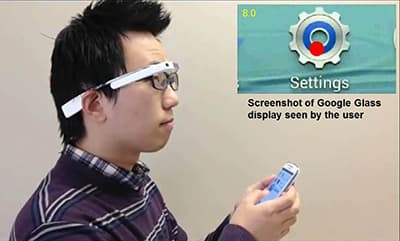Newly Developed Magnifying Screen App To Aid Smartphone Users With Poor Eyesight
A group of researchers from the Schepens Eye Research Institute of Massachusetts Eye and Ear and the Harvard Medical School has initialized a philanthropic movement by successfully launching a smartphone application that aids people with visual impairments. The new app, depending on the virtual reality and gesture control technology, projects an already transformed the smartphone screen to Google Glass flexible, to the users' head movement.
Gang Luo, Senior author of the relevant paper and associate scientist at Schepens Eye Research Institute of Mass explained that the application will lend a helping hand towards the people who suffer from low-vision problems. Normally, when a user tries the “pinch-to-zoom†or similar features available in a smartphone, he loses a large portion of the context and it becomes hard for him to understand which section he was at just now. To significantly improve such a scenario, the group connected a Google glass to the smartphone.

The image is wirelessly transferred from the smartphone to google glass and later it is controlled according to the user’s head movement. Also, the screen context is not lost, but rather it is enlarged significantly according to the requirement. According to the statistics as posted in the press release, approximately 1.5M Americans aged more than 45 years suffer from visual disturbances and a small screen increases the difficulty. Additionally, even with the best responsive design, words written in small fonts and other “hidden†details could not catch their attention.
Scientists conducted an experimental survey where they have given one set of people, a head-motion Google Glass application and the other a smartphone with a built-in zoom feature enabled. As a result, it came out that the group using the latest head-based system had reduced the average trial time in contrast to conventional manual scrolling by nearly 28%.
First author, Shrinivas Pundlik expressed that smart lenses such as Microsoft’s Hololens and Epson's Moverio could be self-sufficient and applied in different aspects such as this. He confirmed that the team would like to also add interactivity and accessibility before commercialization. The compete research work was published in the IEEE Transactions on Neural Systems and Rehabilitation Engineering journal.
Watch demonstration of the system here:
Source: #-Link-Snipped-#
Gang Luo, Senior author of the relevant paper and associate scientist at Schepens Eye Research Institute of Mass explained that the application will lend a helping hand towards the people who suffer from low-vision problems. Normally, when a user tries the “pinch-to-zoom†or similar features available in a smartphone, he loses a large portion of the context and it becomes hard for him to understand which section he was at just now. To significantly improve such a scenario, the group connected a Google glass to the smartphone.

The image is wirelessly transferred from the smartphone to google glass and later it is controlled according to the user’s head movement. Also, the screen context is not lost, but rather it is enlarged significantly according to the requirement. According to the statistics as posted in the press release, approximately 1.5M Americans aged more than 45 years suffer from visual disturbances and a small screen increases the difficulty. Additionally, even with the best responsive design, words written in small fonts and other “hidden†details could not catch their attention.
Scientists conducted an experimental survey where they have given one set of people, a head-motion Google Glass application and the other a smartphone with a built-in zoom feature enabled. As a result, it came out that the group using the latest head-based system had reduced the average trial time in contrast to conventional manual scrolling by nearly 28%.
First author, Shrinivas Pundlik expressed that smart lenses such as Microsoft’s Hololens and Epson's Moverio could be self-sufficient and applied in different aspects such as this. He confirmed that the team would like to also add interactivity and accessibility before commercialization. The compete research work was published in the IEEE Transactions on Neural Systems and Rehabilitation Engineering journal.
Watch demonstration of the system here:
Source: #-Link-Snipped-#
Replies
You are reading an archived discussion.
Related Posts
Here's super cool TED talk by Tim Urban of 'WaitButWhy'. There's lot of learn, so do watch it and share your thoughts below.
Remember the 2014 hit Sci-fi Film Interstellar? In the film, Cooper, a former NASA pilot was instructed by Dr Brand to head the Endurance spaceship to a wormhole in search...
I have completed my B.Tech\IT degree in 2012. I always wanted to become programmer and that is the reason I choose engineering after completing my diploma. I have also completed...
Mahindra recently launched the new Scorpio Adventure in India for a starting price of ₹ 13.07 Lakhs (ex-showroom, Mumbai). Based on the Mahindra Scorpio S10 variant, the SUV packs in...
ASUS's mega popular ZenFone series in India just got a new entrant with the launch of the company's revamped variant the 'ZB452KG' model ZenFone Go 4.5. The phone is special...
